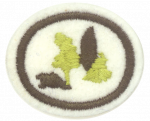Difference between revisions of "AY Honors/Shrubs/Answer Key/es"
(Created page with "{{clear}}") |
(Created page with "{{clear}}") |
||
| Line 96: | Line 96: | ||
{{clear}} | {{clear}} | ||
| − | + | {{clear}} | |
'''Vine maple''' "Acer circinatum" grows up to 20 feet tall in western parts of British Columbia, Washington, Oregon and northern California. The deciduous leaves turn yellow, orange and red in the fall. | '''Vine maple''' "Acer circinatum" grows up to 20 feet tall in western parts of British Columbia, Washington, Oregon and northern California. The deciduous leaves turn yellow, orange and red in the fall. | ||
Revision as of 22:57, 28 February 2021
| Abustos | ||
|---|---|---|
| Asociación General
|
Destreza: 2 Año de introducción: 1938 |
|
Requisitos
1
These are the differences between trees and shrubs:
- Shrubs do not grow as tall as trees, generally not reaching higher than 4.5 meters
 .
. - A shrub's trunk has a circumference of less than 24 cm
 at 1.4 meters
at 1.4 meters above the ground.
above the ground. - Shrubs often have multiple trunks, while trees generally have a single, central trunk.
2
3
These shrubs grow in many areas. The table below indicates where the plants grow in the wild, and where they are cultivated.
| Shrub | Wild | Cultivated |
|---|---|---|
| Azalea | North America, Asia, Europe, Australia | Worldwide |
| Clematis | Temperate Zones, Worldwide | Temperate Zones, Worldwide |
| Forsythia | Asia, Europe | North America |
| Hibiscus | Worldwide | Worldwide |
| Lilac | Europe, Asia | Worldwide |
| Mountain Laurel | Eastern North America |
4
5
{{Shrub
| name = Mistletoe
| latin_name = Santalales
| image = MistletoeInSilverBirch.jpg
| image_caption = Mistletoe on a Silver birch tree
| description = Mistletoe is a plant parasitic on the branches of a tree or shrub. The species grow on a wide range of trees, and can eventually prove fatal to them where infestation is heavy, though damage more commonly only results in growth reduction. All mistletoes are hemiparasites, bearing evergreen leaves that carry out some photosynthesis on their own, relying on the host mainly for water and the mineral nutrients it carries.
6
Vine maple "Acer circinatum" grows up to 20 feet tall in western parts of British Columbia, Washington, Oregon and northern California. The deciduous leaves turn yellow, orange and red in the fall.
7
Because most shrubs bloom in the spring, this honor will be easiest to earn during that season. Some shrubs hold their blossoms through the summer, and a few will even bloom well into autumn. Witch Hazel is a very unusual shrub in that it does not bloom until October or November. During this time, it may have on its branches yellow leaves, full blossoms, and ripe nuts from the previous year's flowers - all at the same time.
This requirement may effectively prevent you from teaching this honor in the winter, but it would be a wonderful honor to offer during the Pathfinder "off season" (that is, during the summer) on a Sabbath afternoon.
| Shrub | Spring | Summer | Autumn |
|---|---|---|---|
| Azalea | |||
| Viburnum | |||
| Lilac | |||
| Blueberry | |||
| Cranberry | |||
| Huckleberry | |||
| Hydrangea | |||
| Sweet Pepperbush | |||
| Buddleia | |||
| Abelia | |||
| Witch Hazel |
Compare this requirement with requirement 6e of the Flowers honor (this is also a requirement that can optionally be used in Flowers - Advanced).
Also compare to Requirement 7 of the Shrubs - Advanced Honor which requires you observe a shrub for a month.
8
Birds love to eat berries from almost any kind of shrub that produces them. Serviceberries, juneberries, currants, mulberry, elderberry, are all very popular with birds, as are blueberries, gooseberries, blackberries, and raspberries. Birds also like to eat the berries from viburnums, spicebush, winterberries, hollies, and dogwoods.
Hummingbirds are attracted to the flowers of the honeysuckle, as they produce a sweet nectar (some people eat honeysuckle nectar too).
9
Birds like to build their nests in shrubs that offer lots of protection from the weather and from predators. Shrubs that provide nesting include dogwoods, viburnums, bayberry, and juniper.
10
For this requirement, we recommend that you use a good field guide. Here are some suggestions:
- A Field Guide to Edible Wild Plants: Eastern and central North America (Peterson Field Guides) by Lee Allen Peterson and Roger Tory Peterson. Note that this book is also very useful for earning the Edible Wild Plants honor, as well as the Pioneering and Wilderness Living honors.
- Field Guide to Trees and Shrubs (Peterson Field Guide Series) by George A Petrides
- Flowering Shrubs: A Magna Field Guide by Jaromir Pokorny
References
- Categoría: Tiene imagen de insignia
- Categoría:Libro de Respuestas de Especialidades JA/Especialidades
- Categoría:Libro de Respuestas de Especialidades JA
- Categoría:Libro de Respuestas de Especialidades JA/Nivel de Destreza 2
- Categoría: Libro de respuestas de especialidades JA/Especialidades introducidas en 1938
- Categoría:Libro de Respuestas de Especialidades JA/Asociación General
- Adventist Youth Honors Answer Book/Nature/es
- Adventist Youth Honors Answer Book/Nature/Primary/es
- Categoría:Libro de Respuestas de Especialidades JA/Etapa 0
- Adventist Youth Honors Answer Book
- Adventist Youth Honors Answer Book/Do at home

